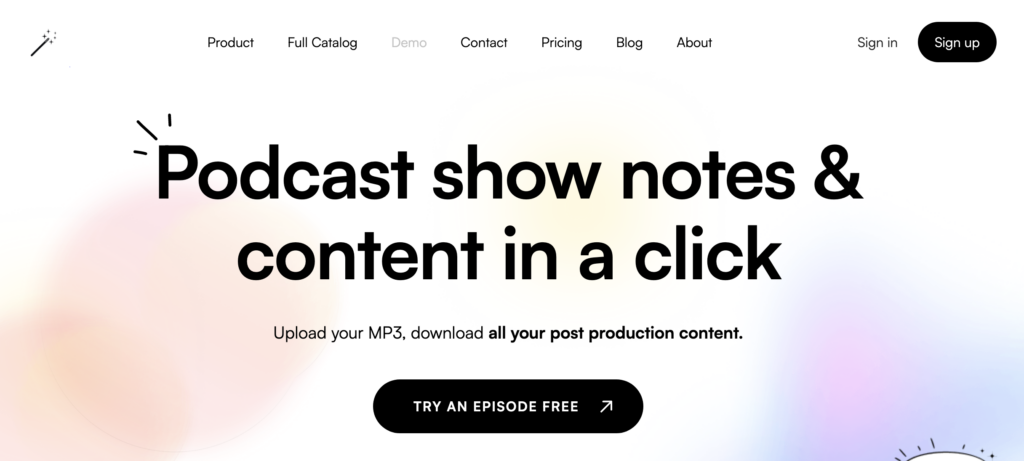Technology
Blaine Bolus Talks About Castmagic And Its Impact On Podcasting Today And The Future
As a podcaster himself, Blane Bolus understood how challenging it is to generate content from his shows. This inspired him to create an app that solves this problem and more. Today, he gives us more details about Castmagic, how it works, and how it’ll benefit podcasters and the industry.
As a podcaster himself, Blaine Bolus understood how challenging it is to generate content from his shows. This inspired him to create an app that solves this problem and more. Today, he gives us more details about Castmagic, how it works, and how it’ll benefit podcasters and the industry.
Blaine Bolus Talks About Castmagic and Its Impact on Podcasting Today and the Future
Who is Blaine Bolus, and What’s Castmagic?
Blaine Bolus co-founded Castmagic, a podcast summation application that turns audio into any asset podcasters need for their growth. Through the app, podcasters can produce transcripts, use custom prompts, generate show notes, split audio into timestamps, and so much more.
Blaine hosts a podcast called the DTC POD. While he’s hosting a podcast, he has a lot of great guests who share great content with his listeners. However, extracting information from his podcast was tricky, making it difficult for him to promote content from the show.
Blaine says, “When we saw all the developments coming out with AI, we thought there are big use cases, specifically for podcasting and being able to solve our own problem, which is hosting a podcast. So, it started as an internal tool we built to write internal show notes and create tweet threads, blog posts, and different types of content.”
Blaine and his team realized that other podcasters had the same problem — creating different types of content from their shows. From there, they decided to spin the tool out as a service. And the reception from its users has been really amazing so far.
How does Castmagic streamline the podcast production process?
Traditionally, to understand what the podcast is all about, podcasters have to find a service that can do the entire transcription, have writers read and understand the transcription, and create content based on the transcript.
If podcasters want to write a blog post focused on that podcast, they’d have to read the entire transcript. If they want to create a quote from the guest of the show, they’d have to find the quote with the timestamp. If they want to write a newsletter saying, “Hey, our podcast is live,’ then they’d have to take that content and repurpose it into a newsletter.
In short, podcasters have to go through several steps in order to create different content for their shows. These steps require a lot of time — a resource that not all podcasters always have. This is where Castmagic comes into the picture.
“There are all these different types of content formats but we focus on the transcription layer, and then are able to extract all the valuable information. We can turn it into highly relevant content in each one of the content outputs available,” Blaine explains.
What are the different types of post-production assets that Castmagic can provide transcription for?
As soon as users upload their audio, the first thing they will get is a transcript, which is broken out by all the different speakers who are in that podcast or conversation. Once the transcript is generated, Castmagic will automatically generate AI content. Castmagic also provides title variations, so users don’t have to come up with titles for their episodes and simply choose from the options provided.
The next are keywords for the show. Castmagic automatically extracts all the important keywords mentioned in the show. Once users have the list of keywords, they can use them for different purposes, whether for SEO or promoting the show in hosting platforms.
Castmagic also creates bios about the speakers. Blaine explains, “If you have a guest, we can instantly provide the bio about the speaker who you’ve been interviewing or who you’ve been talking to.”
Another output Castmagic can produce is the introduction of the show. The introduction comprises several sentences about what the conversation is going to be between the interviewer and the guests or what the podcast is about. “We also provide a timestamped overview. So that’s kind of the chapters to the show, what happened at each different time in the episode,” Blaine adds.
The next thing Castmagic provides is questions. The platform comes up with ten important questions a listener might ask about that show, as well as the answers to those questions based on the information provided.
Blaine continues, “We also do a breakdown on what we call key topics and bullets. This is just like the meat and potatoes of the core information covered in any conversation. It breaks down into topics and subtopics, so it’s very helpful, especially for writers or other people who might try to repurpose the content.”
With this feature, podcasters can easily get the key facts mentioned in the entire episode. These key facts are broken out by their parent topic, meaning information is already organized.
Castmagic also has its clip finder, which helps video editors find short and memorable quotes and use them when repurposing the podcast. Basically, Castmagic identifies the speaker who said the quote and the timestamp on where to find that quote and creates a title for that quote.
The other output Castmagic can provide is a reel script. This gives the creators a script written in the first-person point of view, which can be very useful when creating an Instagram Reel. Blaine says, “They’d be able to read it out in first person and talk about what they covered in that episode.”
Castmagic can also provide a LinkedIn post. It’s basically a short-form social media post talking about the content of the episode. The content generated is ready to go, so creators just have to publish them on their preferred schedule.
Another feature that Castmagic already has is its magic chat function. It allows users to make more content output using a custom prompt.
Blaine shared some of his secrets and mentioned that he has been using this feature to come up with a thank-you note for the guests of a particular episode. He’ll use it like a ChatGPT and type the prompt, “Given this episode, write a thank you note to our guests.” Castmagic will instantly create content based on that prompt.
Since the prompt is customizable, users can maximize this feature to contain all sorts of content, like asking Castmagic to determine the five most important things listeners can learn from the episode. This feature is an excellent way of creating a specific type of content without exerting too much time and effort actually creating it.
Lastly, Castmagic also produces a tweet thread. Instead of using random tweets about different snippets in the show, the tool can take the entire show and creates a powerful tweet thread broken into 10 to 15 tweets about the topics covered in the episode.
With all the features Castmagic offers, extracting and repurposing a podcast episode to any type of content you want becomes a breeze. Blaine adds, “Whether it’s on social media, sort of a visual image, an audiogram, or an actual video clip, you can just use that and plug it right in.”
Can you share some success stories or feedback from podcasters using Castmagic?
One podcaster who uses and loves Castmagic is Noah Kagan from Noah Kagan Presents. Noah really liked how Castmagic was able to streamline their content creation process and pull out more valuable content from their episodes, which they can use in their growth strategy.

Besides Noah, there are a lot of other podcasters who are just mind-blown about the amount of time they can save when using Castmagic. Blaine shares, “When they see the product, they’re like, ‘I want to give you a hug through my video screen because you just saved me an entire week of work.’”
The response of Castmagic users has been phenomenal. Blaine can’t wait to work with some of the biggest names in podcasting in the future. He says, “The ability to surface really important content inside of long-form audio provides massive value not only to the creator but to their audience, as well.”
How does Castmagic handle audio quality issues?
These AI tools today can turn muddy audio bits that sound like they were recorded in the 1920s and transcribe them into clear audio files. In fact, Blaine is proud to share that Castmagic can provide the best-in-class transcription and make that available to anyone using the tool.
How does Castmagic differentiate itself from other similar platforms?
The key differentiator of Castmagic is its workflow and understanding of its audience. Blaine explains, “If you’re looking at the transcription layer, that’s one important component. But once you have the audio, there’s another phase, which is processing and extracting value and taking and turning that into the right content assets.”

For Blaine, Castmagic’s core competency lies in its ability to extract value from audio and repurpose it into content that works. Unlike most platforms, Castmagic doesn’t use AI to write a bunch of nonsense based on audio files; the tool gets content from the audio files as accurately and fast as possible.
Competition-wise, Castmagic wants to become a valuable workflow tool. Aside from handling transcription as an essential input to their equation, the team behind Castmagic also considers where the content is going and how they can build better solutions to help push content to end destinations faster.
How does Castmagic’s pricing works?
Castmagic’s pricing is SaaS-based, meaning podcasters can choose from different pricing packages. And from those packages, they can either upgrade as required. Blaine explains, “Pricing is something we’re letting the market dictate right now. Basically, what it comes down to is for our entry package, you can get it on Castmagic for $39 a month. That gives you access to over four hours of audio, including processing and creating content.”
According to Blaine, Castmagic will offer an option soon wherein podcasters can pay around 10 to 12 cents per minute of additional content. This pricing strategy has been used by agencies and content houses working across multiple shows, and Blaine considers it a “big growth lever” for Castmagic.
How does Castmagic approach data privacy?
Castmagic is built with the best-in-class data privacy. It also transcribes with the information provided and then gives that information back to its users.
Castmagic’s use cases are more structured around the idea of using content as part of the production workflow of podcasters and being able to generate more content. Unlike other platforms, it’s not focused on being a proprietary data platform discussing confidential information.
Has Castmagic worked on collaborations and partnerships?
Castmagic hasn’t partnered yet with anyone, but Blaine shares they’re looking at different options between hosting platforms or other big agencies that have a significant impact on the creator network.
Blaine adds, “Our job was to, again, get the product built really quickly, stood up high-functioning, and then start to explore partnerships and growth lever on. We have been exploring partnerships on the tech-enabled side of things, so many of those providers, like transcription providers. They’re looking to partner with us and provide us with support to make case studies with us and how we’re applying their technology to podcasting.”
Are there any future developments or features that Castmagic is working on?
There are a lot of things on the roadmap for Castmagic, one allowing podcasters to start indexing their entire content catalog. Blaine adds, “So we’re going to have a functionality where we’re able to query and create content that’s sourced across the entire content catalog.”
The other plans Castmagic has for the future are a bit simpler. For instance, the platform will offer more language support, such as English, Dutch, French, German, Hindi, Indonesian, Italian, Japanese, Korean, Mandarin (Simplified), Norwegian, Polish, Portuguese, Russian, Spanish, Swedish, Turkish, and Ukrainian, soon. Adding this feature stems from the demand of Spanish, German, French, and Italian speakers who were able to use Castmagic.
Castmagic also supports YouTube links now, so users can paste a YouTube link on the app and it’ll work its magic by generating all the same content.
How will AI impact the podcast industry?
Blaine proudly states that Castmagic is the best tool right now because it doesn’t have the limitations of AI. He says, “The reason that we even tried to productize it is some of the limitations of AI were being able to take so much text in the sense of an entire podcast transcript. You can’t take a whole podcast transcript and paste it into ChatGPT, right?”
“I think as a creator, the reason Castmagic is such a good option is that we handle all that legwork and are able to create those content assets for you,” Blaine adds.
Blaine advises that for creators to use AI for their growth, they should use the tech to streamline their workflow and get as many assets as possible while remaining authentic to their audience. Spam-creating content with AI will not resonate well with any audience and, in the long run, negatively impact any creator’s brand.
“But if you can use AI to scrape out, for example, all of this relevant and valuable information to your audience, you’re still being authentic to yourself and just using AI to do the legwork and heavy lifting,” Blaine says.
For Blaine, being able to create all sorts of content while staying authentic is one of the biggest things to look out for in the podcasting arena. He added that Castmagic has started looking into use cases for YouTubers, streamers, and webinars. The tool recently introduced its MP4 file support, as well.
Blaine cites how fast AI has picked up over the past few years by mentioning its capability to create articles, images, and other types of content today. He also encourages all creators to utilize different AI-powered tools, like ChatGPT. He even calls ChatGPT a sparring partner, which enables creators to work and create different workflows and assets.
“There are just so many tools for creators. So, if you’re a creator, I encourage you to play around with everything and see what works for your workflows and see what tools really help you take the most legwork off of your plate. So, you can focus on the things you’re really good at, which are creative direction, engaging with your audience, and creating great content,” Blaine concludes.



















